Analyzing the Sources and Variations of Nighttime Lights in Hong Kong from VIIRS Monthly Data
Abstract
:1. Introduction
- We analyzed the long-term pattern of nighttime lights from the VIIRS/DNB monthly data in Hong Kong based on land use data. We utilized an unsupervised clustering method to identify the specific sources and variations, including constructions of artificial islands and airport expansion. The methods and analysis strategies used in this study can be expanded to other studies for intra-urban analysis of nighttime lights.
- We find a significant correlation between diffuse light (background nighttime lights) and relative humidity (R = 0.68). Background nighttime lights were brighter in wet months and dimmer in dry months. With increased water content in atmosphere, Mie scattering is stronger; thus, there is more diffuse light—a phenomenon constantly being overlooked in nighttime lights.
2. Data
2.1. VIIRS/DNB Monthly Data
2.2. Land Use Data
2.3. Environmental Data
3. Method
Agglomerative Clustering
4. Results and Analysis
4.1. Long-Term Nighttime Lights in Hong Kong
4.2. Monthly Nighttime Lights Based on Land Use
4.3. Identified Regions of Interest
4.3.1. Regions with Increasing Nighttime Lights
4.3.2. Wildfires
4.4. Correlation with Humidity
4.5. Correlation with Environmental Factors
5. Discussion
6. Conclusions
Author Contributions
Funding
Data Availability Statement
Acknowledgments
Conflicts of Interest
Abbreviations
| ALAN | Artificial Light at Night; |
| DMSP/OLS | Defense Meteorological Program Operational Line-Scan System; |
| VIIRS | Visible Infrared Imaging Radiometer Suite; |
| DNB | Day/Night Band; |
| NSB | Night Sky Brightness; |
| SQM | Sky Quality Meter; |
| GIC | Government, Institution or Community; |
| HEP | High Energy Particle; |
| PM2.5 | Fine Suspended Particulates; |
| PM10 | Respirable Suspended Particulates. |
References
- Stevens, R.G. Light-at-night, circadian disruption and breast cancer: Assessment of existing evidence. Int. J. Epidemiol. 2009, 38, 963–970. [Google Scholar] [CrossRef] [PubMed]
- Elvidge, C.D.; Baugh, K.; Zhizhin, M.; Hsu, F.C.; Ghosh, T. VIIRS night-time lights. Int. J. Remote Sens. 2017, 38, 5860–5879. [Google Scholar] [CrossRef]
- Giordano, E.; Ong, C.E. Light festivals, policy mobilities and urban tourism. Tour. Geogr. 2017, 19, 699–716. [Google Scholar] [CrossRef]
- Estrada Grajales, C.A.; Mitchell, P.; Caldwell, G.; Yang, R.; Johnstone, S. Projecting the new world city: The city as spectacle in an urban light festival. In Proceedings of the 5th MEDIACITY International Conference and Exhibition. School of Architecture, Design and Environment and i-DAT, Plymouth University, Plymouth, UK, 1–3 May 2015; pp. 244–261. [Google Scholar]
- Small, C.; Pozzi, F.; Elvidge, C.D. Spatial analysis of global urban extent from DMSP-OLS night lights. Remote Sens. Environ. 2005, 96, 277–291. [Google Scholar] [CrossRef]
- Bennett, M.M.; Smith, L.C. Advances in using multitemporal night-time lights satellite imagery to detect, estimate, and monitor socioeconomic dynamics. Remote Sens. Environ. 2017, 192, 176–197. [Google Scholar] [CrossRef]
- Levin, N.; Kyba, C.C.; Zhang, Q.; de Miguel, A.S.; Román, M.O.; Li, X.; Portnov, B.A.; Molthan, A.L.; Jechow, A.; Miller, S.D.; et al. Remote sensing of night lights: A review and an outlook for the future. Remote Sens. Environ. 2020, 237, 111443. [Google Scholar] [CrossRef]
- Hu, Z.; Hu, H.; Huang, Y. Association between nighttime artificial light pollution and sea turtle nest density along Florida coast: A geospatial study using VIIRS remote sensing data. Environ. Pollut. 2018, 239, 30–42. [Google Scholar] [CrossRef]
- Rodríguez, A.; García, D.; Rodríguez, B.; Cardona, E.; Parpal, L.; Pons, P. Artificial lights and seabirds: Is light pollution a threat for the threatened Balearic petrels? J. Ornithol. 2015, 156, 893–902. [Google Scholar] [CrossRef]
- Harding, B.N.; Palomar-Cros, A.; Valentín, A.; Espinosa, A.; Sánchez de Miguel, A.; Castaño-Vinyals, G.; Pollán, M.; Perez, B.; Moreno, V.; Kogevinas, M. Comparing Data from Three Satellites on Artificial Light at Night (ALAN): Focusing on Blue Light’s Influence on Colorectal Cancer in a Case–Control Study in Spain. Environ. Health Perspect. 2024, 132, 057702. [Google Scholar] [CrossRef]
- Pun, C.S.; So, C.W. Night-sky brightness monitoring in Hong Kong. Environ. Monit. Assess. 2012, 184, 2537–2557. [Google Scholar] [CrossRef]
- Gaston, K.J.; Sánchez de Miguel, A. Environmental impacts of artificial light at night. Annu. Rev. Environ. Resour. 2022, 47, 373–398. [Google Scholar] [CrossRef]
- Linares Arroyo, H.; Abascal, A.; Degen, T.; Aubé, M.; Espey, B.R.; Gyuk, G.; Hölker, F.; Jechow, A.; Kuffer, M.; Sánchez de Miguel, A.; et al. Monitoring, trends and impacts of light pollution. Nat. Rev. Earth Environ. 2024, 5, 417–430. [Google Scholar] [CrossRef]
- Kyba, C.C.; Altıntaş, Y.Ö.; Walker, C.E.; Newhouse, M. Citizen scientists report global rapid reductions in the visibility of stars from 2011 to 2022. Science 2023, 379, 265–268. [Google Scholar] [CrossRef]
- Barentine, J.C. Night sky brightness measurement, quality assessment and monitoring. Nat. Astron. 2022, 6, 1120–1132. [Google Scholar] [CrossRef]
- Espey, B.; McCauley, J. Initial Irish light pollution measurements and a new Sky Quality Meter-based data logger. Light. Res. Technol. 2014, 46, 67–77. [Google Scholar] [CrossRef]
- Pun, C.S.J.; So, C.W.; Leung, W.Y.; Wong, C.F. Contributions of artificial lighting sources on light pollution in Hong Kong measured through a night sky brightness monitoring network. J. Quant. Spectrosc. Radiat. Transf. 2014, 139, 90–108. [Google Scholar] [CrossRef]
- Bertolo, A.; Binotto, R.; Ortolani, S.; Sapienza, S. Measurements of night sky brightness in the veneto region of italy: Sky quality meter network results and differential photometry by digital single lens reflex. J. Imaging 2019, 5, 56. [Google Scholar] [CrossRef]
- Massetti, L.; Materassi, A.; Sabatini, F. NSKY-CD: A System for Cloud Detection Based on Night Sky Brightness and Sky Temperature. Remote Sens. 2023, 15, 3063. [Google Scholar] [CrossRef]
- Aceituno, J.; Sánchez, S.; Aceituno, F.J.; Galadí-Enríquez, D.; Negro, J.J.; Soriguer, R.C.; Gomez, G.S. An all-sky transmission monitor: ASTMON. Publ. Astron. Soc. Pac. 2011, 123, 1076. [Google Scholar] [CrossRef]
- Bustamante-Calabria, M.; Sánchez de Miguel, A.; Martín-Ruiz, S.; Ortiz, J.L.; Vílchez, J.M.; Pelegrina, A.; García, A.; Zamorano, J.; Bennie, J.; Gaston, K.J. Effects of the COVID-19 lockdown on urban light emissions: Ground and satellite comparison. Remote Sens. 2021, 13, 258. [Google Scholar] [CrossRef]
- Guo, X.; Tian, Z.; Zhao, Y.; Su, X. Impact of urban air pollutants on the night sky brightness and color in Hohhot. Sustain. Cities Soc. 2023, 96, 104671. [Google Scholar] [CrossRef]
- Jechow, A.; Ribas, S.J.; Domingo, R.C.; Hölker, F.; Kolláth, Z.; Kyba, C.C. Tracking the dynamics of skyglow with differential photometry using a digital camera with fisheye lens. J. Quant. Spectrosc. Radiat. Transf. 2018, 209, 212–223. [Google Scholar] [CrossRef]
- Wallner, S. Usage of vertical fisheye-images to quantify urban light pollution on small scales and the impact of LED conversion. J. Imaging 2019, 5, 86. [Google Scholar] [CrossRef] [PubMed]
- Jechow, A. Let there be Skyglow—Light pollution from a large outdoor music festival (Lollapalooza Berlin 2016). Sci. Rep. 2024, 14, 11725. [Google Scholar] [CrossRef]
- Han, P.; Huang, J.; Li, R.; Wang, L.; Hu, Y.; Wang, J.; Huang, W. Monitoring trends in light pollution in China based on nighttime satellite imagery. Remote Sens. 2014, 6, 5541–5558. [Google Scholar] [CrossRef]
- de Miguel, A.S.; Kyba, C.C.; Aubé, M.; Zamorano, J.; Cardiel, N.; Tapia, C.; Bennie, J.; Gaston, K.J. Colour remote sensing of the impact of artificial light at night (I): The potential of the International Space Station and other DSLR-based platforms. Remote Sens. Environ. 2019, 224, 92–103. [Google Scholar] [CrossRef]
- Palomar-Cros, A.; Espinosa, A.; Bará, S.; Sánchez, A.; Valentín, A.; Cirach, M.; Castaño-Vinyals, G.; Papantoniou, K.; Blay, N.; de Cid, R.; et al. Outdoor artificial light-at-night and cardiometabolic disease risk: An urban perspective from the Catalan GCAT cohort study. Am. J. Epidemiol. 2024, 194, kwae269. [Google Scholar] [CrossRef]
- Liu, S.K.; So, C.W.; Pun, J.C.S. Using Time-Series Satellite Imagery to Detect Artificial Light At Night: The Case of Luojia-1 and International Space Station. In Proceedings of the IGARSS 2024—2024 IEEE International Geoscience and Remote Sensing Symposium, Athens, Greece, 7–12 July 2024; pp. 1305–1308. [Google Scholar]
- Baugh, K.; Elvidge, C.D.; Ghosh, T.; Ziskin, D. Development of a 2009 stable lights product using DMSP-OLS data. Proc. Asia-Pac. Adv. Netw. 2010, 30, 114. [Google Scholar] [CrossRef]
- Gibson, J.; Olivia, S.; Boe-Gibson, G.; Li, C. Which night lights data should we use in economics, and where? J. Dev. Econ. 2021, 149, 102602. [Google Scholar] [CrossRef]
- Román, M.O.; Wang, Z.; Sun, Q.; Kalb, V.; Miller, S.D.; Molthan, A.; Schultz, L.; Bell, J.; Stokes, E.C.; Pandey, B.; et al. NASA’s Black Marble nighttime lights product suite. Remote Sens. Environ. 2018, 210, 113–143. [Google Scholar] [CrossRef]
- Xu, P.; Wang, Q.; Jin, J.; Jin, P. An increase in nighttime light detected for protected areas in mainland China based on VIIRS DNB data. Ecol. Indic. 2019, 107, 105615. [Google Scholar] [CrossRef]
- Zhang, Q.; Schaaf, C.; Seto, K.C. The vegetation adjusted NTL urban index: A new approach to reduce saturation and increase variation in nighttime luminosity. Remote Sens. Environ. 2013, 129, 32–41. [Google Scholar] [CrossRef]
- Yu, B.; Shi, K.; Hu, Y.; Huang, C.; Chen, Z.; Wu, J. Poverty evaluation using NPP-VIIRS nighttime light composite data at the county level in China. IEEE J. Sel. Top. Appl. Earth Obs. Remote Sens. 2015, 8, 1217–1229. [Google Scholar] [CrossRef]
- Jean, N.; Burke, M.; Xie, M.; Davis, W.M.; Lobell, D.B.; Ermon, S. Combining satellite imagery and machine learning to predict poverty. Science 2016, 353, 790–794. [Google Scholar] [CrossRef]
- Li, X.; Li, D. Can night-time light images play a role in evaluating the Syrian Crisis? Int. J. Remote Sens. 2014, 35, 6648–6661. [Google Scholar] [CrossRef]
- Cao, C.; Shao, X.; Uprety, S. Detecting light outages after severe storms using the S-NPP/VIIRS day/night band radiances. IEEE Geosci. Remote Sens. Lett. 2013, 10, 1582–1586. [Google Scholar] [CrossRef]
- Wang, Z.; Román, M.; Sun, Q.; Molthan, A.; Schultz, L.; Kalb, V. Monitoring disaster-related power outages using NASA black marble nighttime light product. ISPRS Int. Arch. Photogramm. Remote Sens. Spat. Inf. Sci. 2018, 42, 1853–1856. [Google Scholar] [CrossRef]
- Román, M.O.; Stokes, E.C.; Shrestha, R.; Wang, Z.; Schultz, L.; Carlo, E.A.S.; Sun, Q.; Bell, J.; Molthan, A.; Kalb, V.; et al. Satellite-based assessment of electricity restoration efforts in Puerto Rico after Hurricane Maria. PLoS ONE 2019, 14, e0218883. [Google Scholar] [CrossRef]
- Bennie, J.; Duffy, J.P.; Davies, T.W.; Correa-Cano, M.E.; Gaston, K.J. Global trends in exposure to light pollution in natural terrestrial ecosystems. Remote Sens. 2015, 7, 2715–2730. [Google Scholar] [CrossRef]
- Liu, S.; So, C.W.; Pun, C.S.J. Analyzing Long-Term Artificial Light at Night Using Viirs Monthly Product with Land Use Data: Preliminary Result of Hong Kong. In Proceedings of the 2021 IEEE International Geoscience and Remote Sensing Symposium IGARSS, Brussels, Belgium, 11–16 July 2021; pp. 6821–6824. [Google Scholar]
- Kyba, C.C.; Aubé, M.; Bará, S.; Bertolo, A.; Bouroussis, C.A.; Cavazzani, S.; Espey, B.R.; Falchi, F.; Gyuk, G.; Jechow, A.; et al. Multiple angle observations would benefit visible band remote sensing using night lights. J. Geophys. Res. Atmos. 2022, 127, e2021JD036382. [Google Scholar] [CrossRef]
- Levin, N. The impact of seasonal changes on observed nighttime brightness from 2014 to 2015 monthly VIIRS DNB composites. Remote Sens. Environ. 2017, 193, 150–164. [Google Scholar] [CrossRef]
- Elvidge, C.D.; Ziskin, D.; Baugh, K.E.; Tuttle, B.T.; Ghosh, T.; Pack, D.W.; Erwin, E.H.; Zhizhin, M. A fifteen year record of global natural gas flaring derived from satellite data. Energies 2009, 2, 595–622. [Google Scholar] [CrossRef]
- Li, X.; Ma, R.; Zhang, Q.; Li, D.; Liu, S.; He, T.; Zhao, L. Anisotropic characteristic of artificial light at night–Systematic investigation with VIIRS DNB multi-temporal observations. Remote Sens. Environ. 2019, 233, 111357. [Google Scholar] [CrossRef]
- Xie, Y.; Weng, Q.; Fu, P. Temporal variations of artificial nighttime lights and their implications for urbanization in the conterminous United States, 2013–2017. Remote Sens. Environ. 2019, 225, 160–174. [Google Scholar] [CrossRef]
- Wang, J.; Aegerter, C.; Xu, X.; Szykman, J.J. Potential application of VIIRS Day/Night Band for monitoring nighttime surface PM2. 5 air quality from space. Atmos. Environ. 2016, 124, 55–63. [Google Scholar] [CrossRef]
- de Miguel, A.S.; Kyba, C.C.; Zamorano, J.; Gallego, J.; Gaston, K.J. The nature of the diffuse light near cities detected in nighttime satellite imagery. Sci. Rep. 2020, 10, 7829. [Google Scholar]
- Polivka, T.N.; Wang, J.; Ellison, L.T.; Hyer, E.J.; Ichoku, C.M. Improving nocturnal fire detection with the VIIRS day–night band. IEEE Trans. Geosci. Remote Sens. 2016, 54, 5503–5519. [Google Scholar] [CrossRef]
- Elvidge, C.D.; Baugh, K.E.; Zhizhin, M.; Hsu, F.C. Why VIIRS data are superior to DMSP for mapping nighttime lights. Proc. Asia-Pac. Adv. Netw. 2013, 35, 62. [Google Scholar] [CrossRef]
- Pedregosa, F.; Varoquaux, G.; Gramfort, A.; Michel, V.; Thirion, B.; Grisel, O.; Blondel, M.; Prettenhofer, P.; Weiss, R.; Dubourg, V.; et al. Scikit-learn: Machine learning in Python. J. Mach. Learn. Res. 2011, 12, 2825–2830. [Google Scholar]
- Ward, J.H., Jr. Hierarchical grouping to optimize an objective function. J. Am. Stat. Assoc. 1963, 58, 236–244. [Google Scholar] [CrossRef]
- Rousseeuw, P.J. Silhouettes: A graphical aid to the interpretation and validation of cluster analysis. J. Comput. Appl. Math. 1987, 20, 53–65. [Google Scholar] [CrossRef]
- Lundgren, D.A.; Cooper, D.W. Effect of humidify on light-scattering methods of measuring particle concentration. J. Air Pollut. Control Assoc. 1969, 19, 243–247. [Google Scholar] [CrossRef]
- Zieger, P.; Fierz-Schmidhauser, R.; Gysel, M.; Ström, J.; Henne, S.; Yttri, K.E.; Baltensperger, U.; Weingartner, E. Effects of relative humidity on aerosol light scattering in the Arctic. Atmos. Chem. Phys. 2010, 10, 3875–3890. [Google Scholar] [CrossRef]
- Elvidge, C.D.; Zhizhin, M.; Ghosh, T.; Hsu, F.C.; Taneja, J. Annual time series of global VIIRS nighttime lights derived from monthly averages: 2012 to 2019. Remote Sens. 2021, 13, 922. [Google Scholar] [CrossRef]
- Tanaka, M. Intraseasonal oscillation and the onset and retreat dates of the summer monsoon over east, southeast Asia and the western Pacific region using GMS high cloud amount data. J. Meteorol. Soc. Jpn. Ser. II 1992, 70, 613–629. [Google Scholar] [CrossRef]
- Pan, C.; Zhao, J.; Chen, H.; Kang, Z.; Chen, S.; Jin, X. The characteristics of the Yangtze flooding during 1998 and 2020 based on atmospheric water tracing. Geophys. Res. Lett. 2023, 50, e2023GL104195. [Google Scholar] [CrossRef]
- Gu, J.; Zhao, C.; Xu, M.; Feng, J.; Li, G.; Zhao, Y.; Hao, X.; Chen, J.; An, H. Global convection-permitting model improves subseasonal forecast of plum rain around Japan. Environ. Res. Lett. 2024, 19, 104021. [Google Scholar] [CrossRef]
- Kocifaj, M.; Bará, S. Diffuse light around cities: New perspectives in satellite remote sensing of nighttime aerosols. Atmos. Res. 2022, 266, 105969. [Google Scholar] [CrossRef]
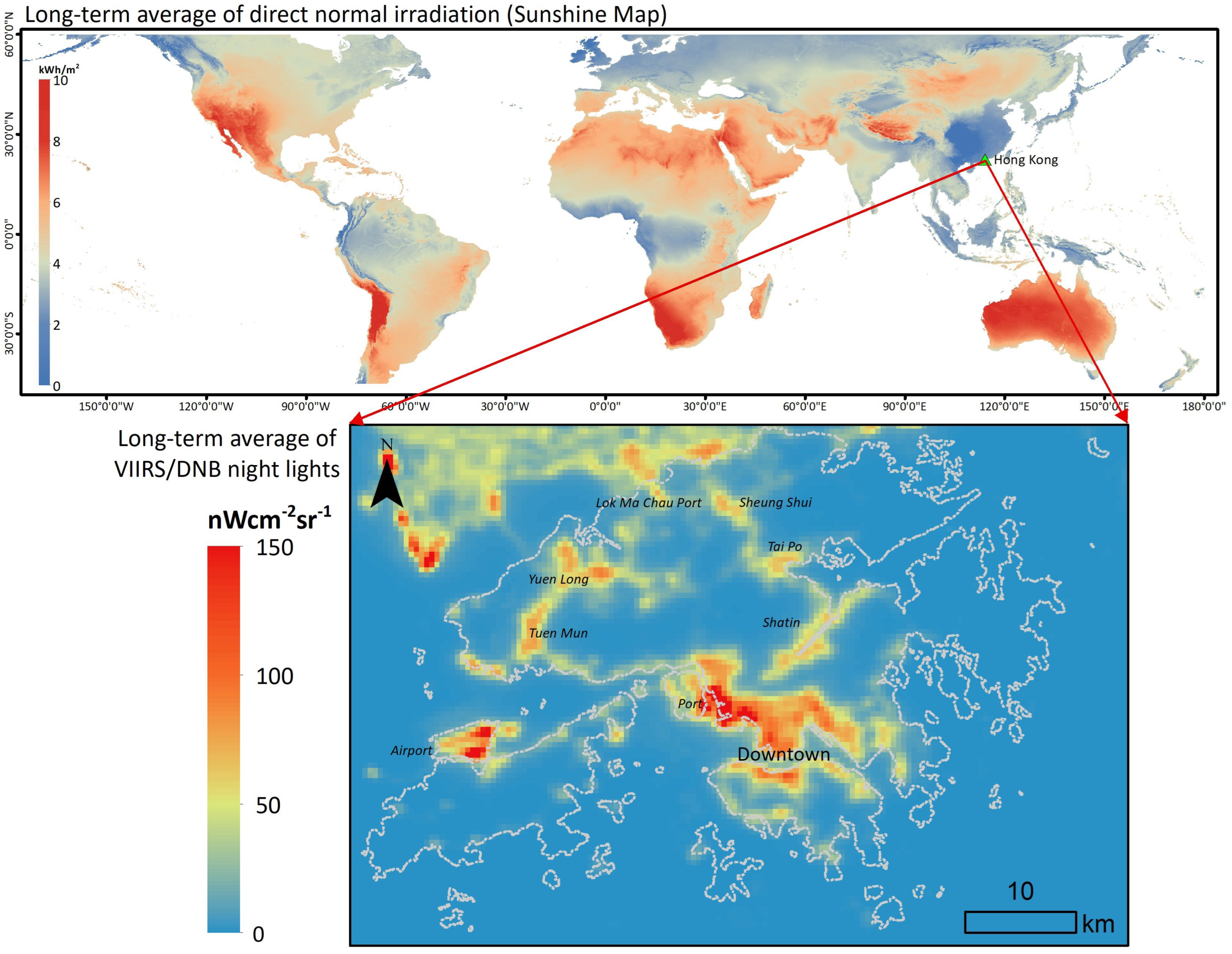
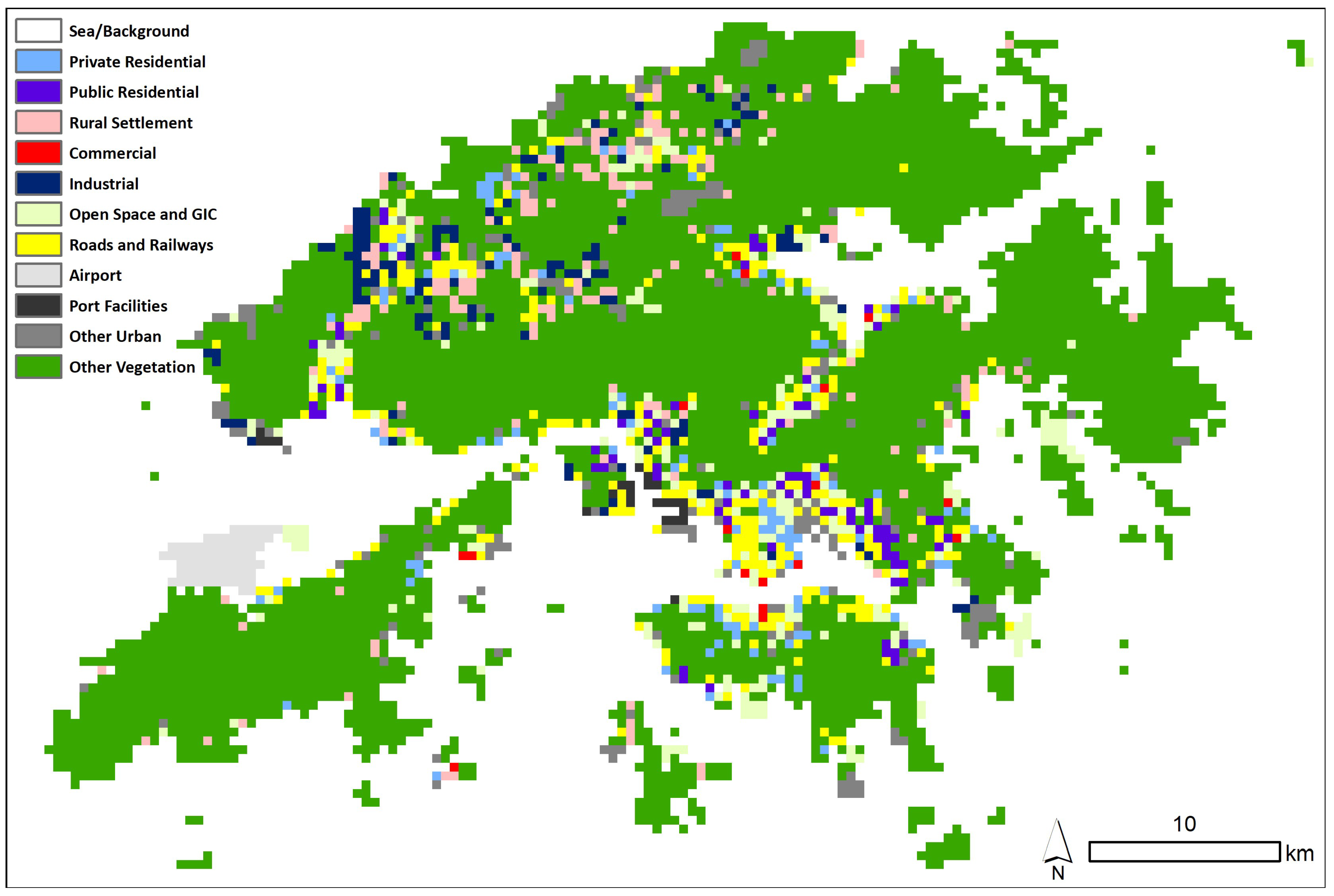
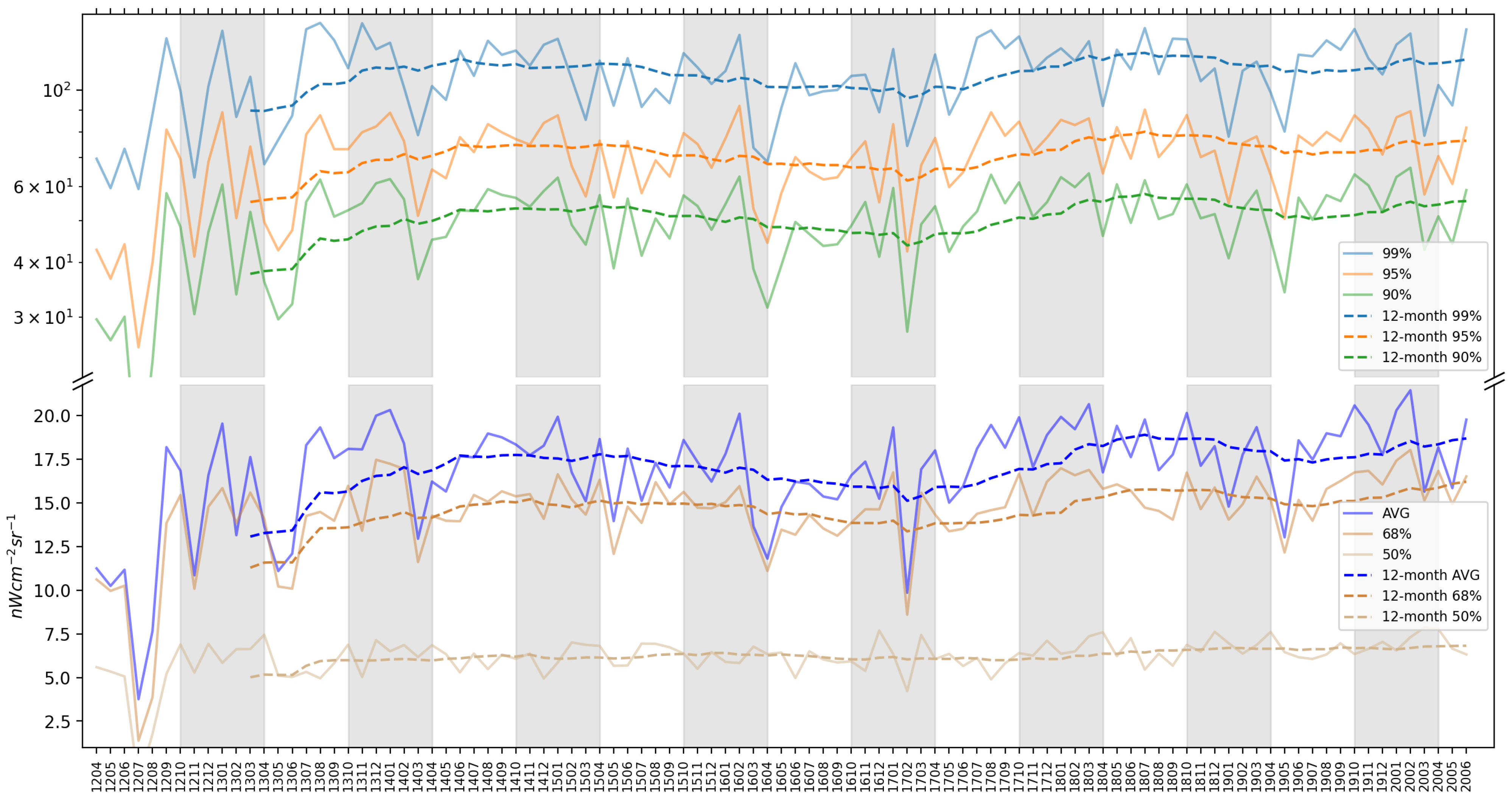


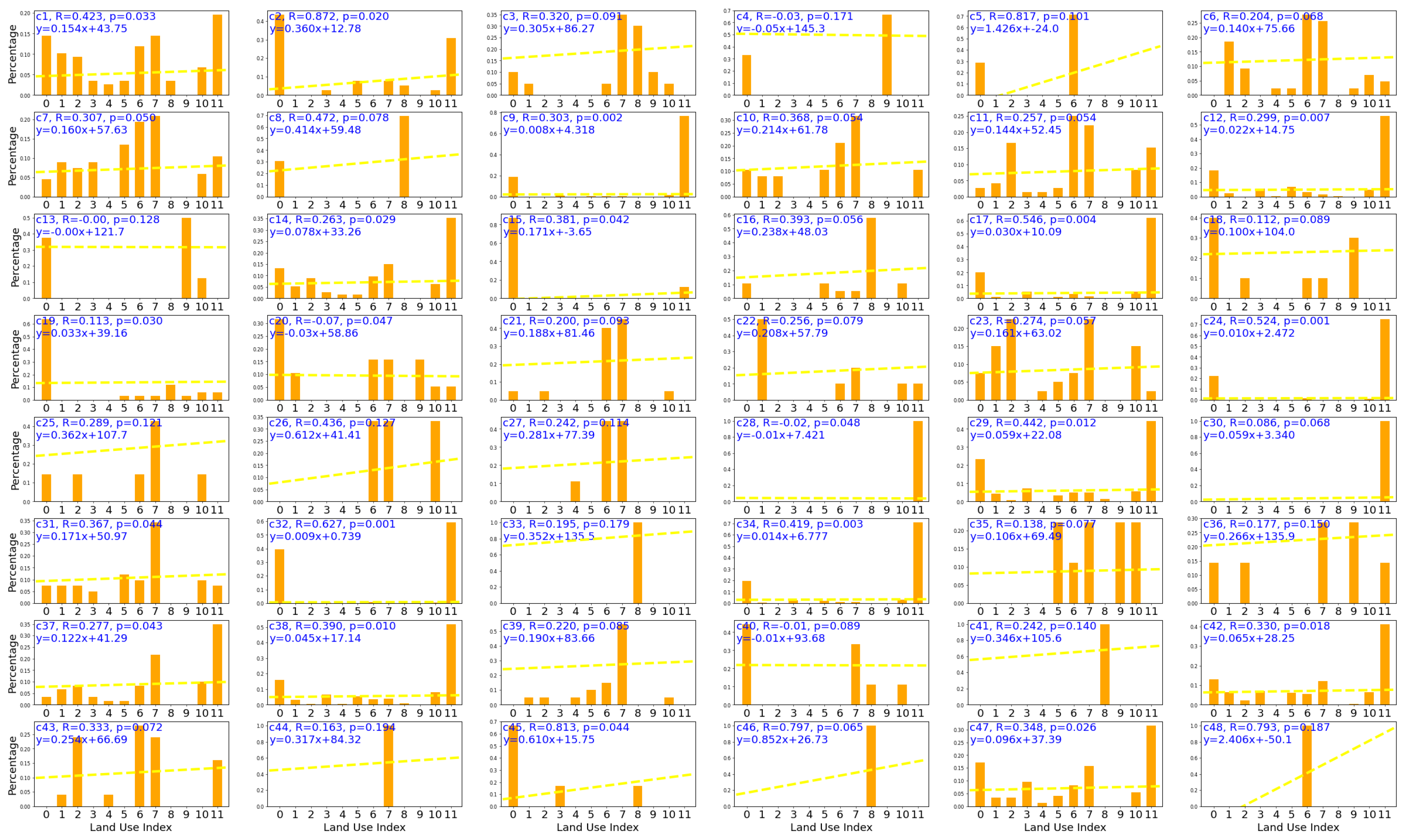

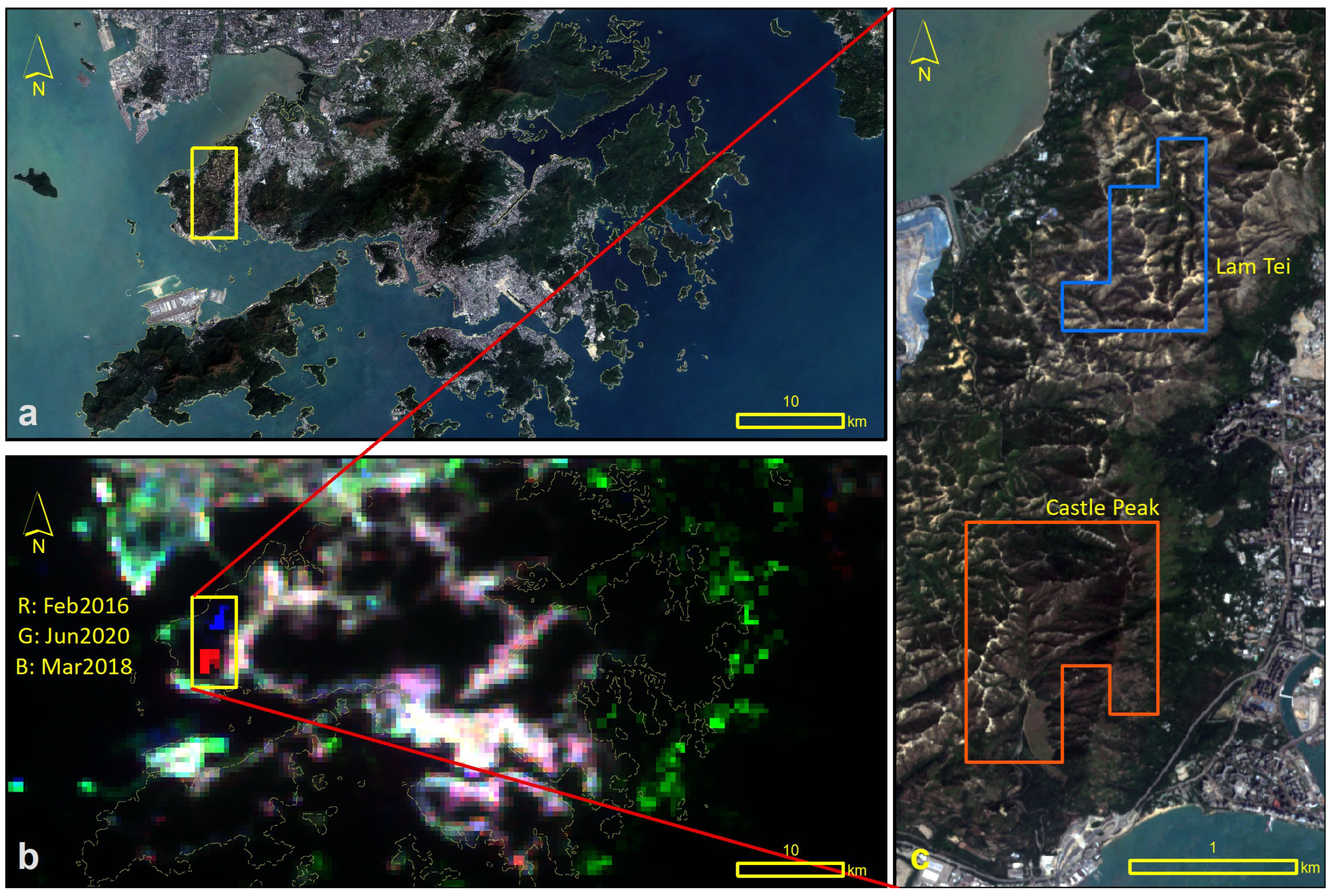
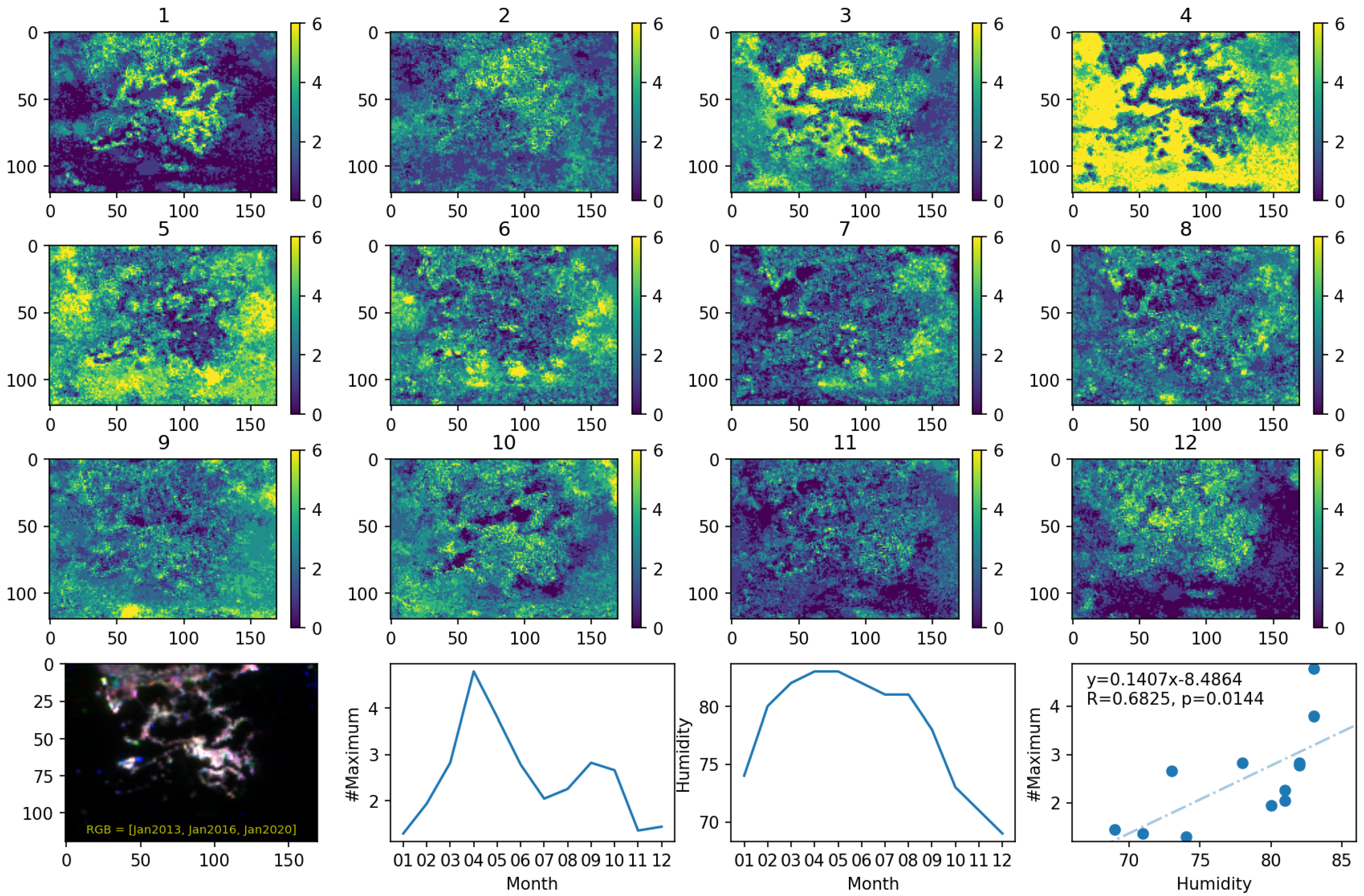

| Index | Land Use | Number of Pixels | Original Land Use |
|---|---|---|---|
| 1 | Private Residential | 121 | Private Residential |
| 2 | Public Residential | 88 | Public Residential |
| 3 | Rural Settlement | 175 | Rural Settlement |
| 4 | Commercial | 17 | Commercial |
| 5 | Industrial | 131 | Industrial Land |
| Industrial Estates/SciTech Parks | |||
| Warehouse and Open Storage | |||
| 6 | Open Space and GIC | 259 | GIC Facilities |
| Open Space and Recreation | |||
| 7 | Roads and Railways | 288 | Roads and Transport Facilities |
| Railways | |||
| 8 | Airport | 67 | Airport |
| 9 | Port Facilities | 23 | Port Facilities |
| 10 | Other Urban | 225 | Cemeteries/Funeral Facilities |
| Utilities | |||
| Vacant Land/Construction in Progress | |||
| 11 | Undeveloped | 4233 | Agricultural Land |
| Fish Ponds/Gei Wais | |||
| Woodland | |||
| Shrubland | |||
| Grassland | |||
| Mangrove/Swamp | |||
| Badland | |||
| Rocky Shore | |||
| Reservoirs | |||
| Streams and Nullahs |
| Factor | R Coefficient | p-Value |
|---|---|---|
| Humidity | 0.6825 | 0.0144 * |
| Sunshine hours | −0.4009 | 0.1965 |
| PM2.5 | −0.3692 | 0.2375 |
| Nitrogen Dioxide | −0.2272 | 0.4778 |
| Nitrogen Oxides | −0.1212 | 0.7074 |
| Ozone | 0.1258 | 0.6967 |
| PM10 | 0.3494 | 0.2656 |
| Sulfur Dioxide | 0.1147 | 0.7225 |
Disclaimer/Publisher’s Note: The statements, opinions and data contained in all publications are solely those of the individual author(s) and contributor(s) and not of MDPI and/or the editor(s). MDPI and/or the editor(s) disclaim responsibility for any injury to people or property resulting from any ideas, methods, instructions or products referred to in the content. |
© 2025 by the authors. Licensee MDPI, Basel, Switzerland. This article is an open access article distributed under the terms and conditions of the Creative Commons Attribution (CC BY) license (https://creativecommons.org/licenses/by/4.0/).
Share and Cite
Liu, S.; So, C.W.; Pun, C.S.J. Analyzing the Sources and Variations of Nighttime Lights in Hong Kong from VIIRS Monthly Data. Remote Sens. 2025, 17, 1447. https://doi.org/10.3390/rs17081447
Liu S, So CW, Pun CSJ. Analyzing the Sources and Variations of Nighttime Lights in Hong Kong from VIIRS Monthly Data. Remote Sensing. 2025; 17(8):1447. https://doi.org/10.3390/rs17081447
Chicago/Turabian StyleLiu, Shengjie, Chu Wing So, and Chun Shing Jason Pun. 2025. "Analyzing the Sources and Variations of Nighttime Lights in Hong Kong from VIIRS Monthly Data" Remote Sensing 17, no. 8: 1447. https://doi.org/10.3390/rs17081447
APA StyleLiu, S., So, C. W., & Pun, C. S. J. (2025). Analyzing the Sources and Variations of Nighttime Lights in Hong Kong from VIIRS Monthly Data. Remote Sensing, 17(8), 1447. https://doi.org/10.3390/rs17081447







